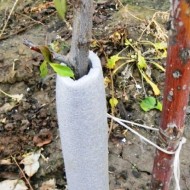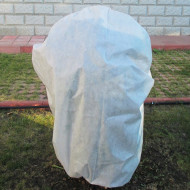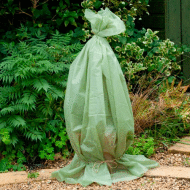Rules and tips for sheltering garden plants for the winter
Content
Why do you need shelter
Warming shrubs and flowers in the garden is an important maintenance procedure. Its correct implementation will protect the garden pet from adverse environmental factors. Shelter construction is a kind of preparation of plants for winter.
In addition to the main function of the shelter - insulation, there are a number of other advantages of this procedure:
- Protection from rodents that like to profit from tree bark.
- Maintaining the integrity of the barrels. Severe frosts often lead to the appearance of cracks in the trunk. To prevent this, trees are treated with whitewash or covered with spruce branches.
- Protection against sunburn, which is possible even in winter. Beginning in February, the sun's rays are detrimental to young bushes up to 5 years old.
There is no set time limit that is universal for all plants. To choose the time for warming, it is important to study the characteristics of each culture. This information will help you understand not only when to cover, but also with what. Gardeners recommend not rushing to insulate a tree or shrub with the onset of the first cold weather. Small frosts will not destroy the culture, but the excess moisture accumulating under the insulation material will provoke rotting and rotting of the root system.
November is the approximate time for the preparation of insulation, since during this period low temperatures are established.
Video: "How to properly cover plants for the winter"
In this video, you will learn how to properly cover plants for the winter.
What plants need to be protected from the cold
First you need to find out the level of resistance of the garden pet to:
- low temperatures;
- fungal diseases;
- scorching sun rays in the second half of winter.
You need to take into account the climatic characteristics of your region. This is one of the main aspects in choosing a thermal insulation method.
The following perennial plants need insulation before wintering:
- grape;
- tamarix;
- young thuja;
- fuchsia;
- stonecrop (only young bushes);
- bully;
- rhododendron (azalea);
- lyatrix;
- wisteria;
- lavender;
- badan;
- pion;
- sage;
- clematis;
- buzulnik;
- lily;
- montbrecia;
- cotton wool;
- chrysanthemum;
- calla;
- knifofia;
- nivyanik;
- sapling (seedlings only);
- chamomile;
- sedum;
- scumpia (seedlings only);
- Turkish carnation;
- the Rose.
Some species of perennials are cold tolerant, so they will need lighter shelter.
Frost-resistant crops include:
- alpine aquilegia;
- aster;
- Shabo carnation;
- monard;
- fern.
The best materials for shelter
The choice of insulation materials is varied. It includes both the old "old-fashioned" methods and modern ones.
"Grandfather's" methods of insulation:
- Hilling. This option is suitable for low-growing plants. To prevent the soil from freezing, a mixture of peat and humus is prepared. The aboveground part of a shrub or flower, as well as the root area, is covered with mulch.
- Lapnik. Spruce or pine branches are an excellent hiding place in regions with relatively warm winters. The plant is well ventilated, which prevents rotting of the root system. In addition, the branches serve as a good shelter from the scalding rays of the sun.Lapnik reliably protects from wind and precipitation, but it is unable to withstand severe frosts.
- Dry leaves will be a good protection from the first cold weather of autumn, however, with the onset of frost, you need to take care of more significant insulation. Re-cooking, the leaves become a kind of fertilizer that has a positive effect on soil fertility. However, not all foliage can be used for shelter construction. Experienced summer residents use dry oak, maple or birch leaves. They are collected in bags and distributed among the beds. The leaves of fruit trees are considered unsuitable for these purposes.
- Straw or dry stems are often used as insulation. But over time, the material cakes and rots, which can provoke fungal diseases. To prevent this, any waterproof material is placed on top of the straw. A little space is left below for air circulation.
Modern materials:
- Non-woven fabric, such as lutrasil, geotextile, spunbond. It retains heat for a long time, so it is advisable to use it for residents of regions with severe winters. The material is used both independently and as an element of a frame structure. The fabric is classified by density: a non-woven with a density of 30 g / m² will protect the plant at a temperature of -7 ° C, and for a material with a density of 60 g / m², the temperature drops to -10 ° C. Agrospanbond is used for agricultural purposes - it is a cover that will reliably protect the plant from a significant cold snap, the scorching rays of the sun, insects and rodents.
- Burlap is an organic material, so it can be buried in the ground without fear of exposure to toxins. When choosing a material as a heater, care should be taken to ensure that there is an open space between it and the plant. Burlap absorbs liquid well. Its excess creates a comfortable habitat for fungal diseases. It is important to use exactly new burlap. If this is not possible, the material should be treated with fungicides.
- Jute mesh is a more expensive type of burlap. It is also much tougher, making it harder to work with.
- The film is able to keep the root space dry. This is definitely an advantage. But the summer resident should remember the need for good air circulation in the shelter.
- Composite fabric is a tandem of geotextile and fine mesh. The option is used for low-growing shrubs, because the size of the canvas is small. When working with the material, you must first prepare the frame, since the canvas does not hold its shape.
Before you start preparing a flower garden for winter, you need to remember one important fact: the plant receives the lion's share of heat and nutrients from the ground. That is why it is important to provide thermal insulation of the soil.
Covers and frame structures serve to protect from winds, sun rays and precipitation, but not from frost. They are relevant for the Moscow region and other regions with relatively mild winters. In areas with severe frosts, they resort to more substantial methods of insulation.
The main methods of shelter are:
- Hilling. It is a distribution at the base of a tree or shrub of a loose mixture of peat, soil and sawdust. The method is relevant for the regions of central Russia, where heat is replaced by a sharp cold snap. Hilling is unacceptable if cracks appear on the stem or trunk. This is fraught with the occurrence of a fungal infection and the death of the plant.
- Mulching is often used with bulbous flowers as they have a shallow root system. The method involves covering the soil with moss, sawdust, foliage and other materials to keep warm.
- Bending down is important for tall thermophilic crops.The technology of this method is very simple: a stake is driven into the ground, to which the ground part of the plant is tied, followed by covering with snow.
- The air-dry method is characterized by the construction of a frame, which is covered with a heat-insulating and waterproof material.
- The air-wet insulation method is similar to the previous one. It involves creating an air gap around a shrub or tree. The stems left after pruning are used as pegs. The plant is covered with thin matter, due to which it receives the required amount of liquid, light and air. It is good oxygen circulation that is the main feature of a properly built greenhouse.
Experienced gardeners prepare for the onset of cold weather in advance. During this period, the plants that live in the country or in the apartment need special care. Compliance with the key norms and rules of insulation will provide a garden pet with a long life and lush flowering.






